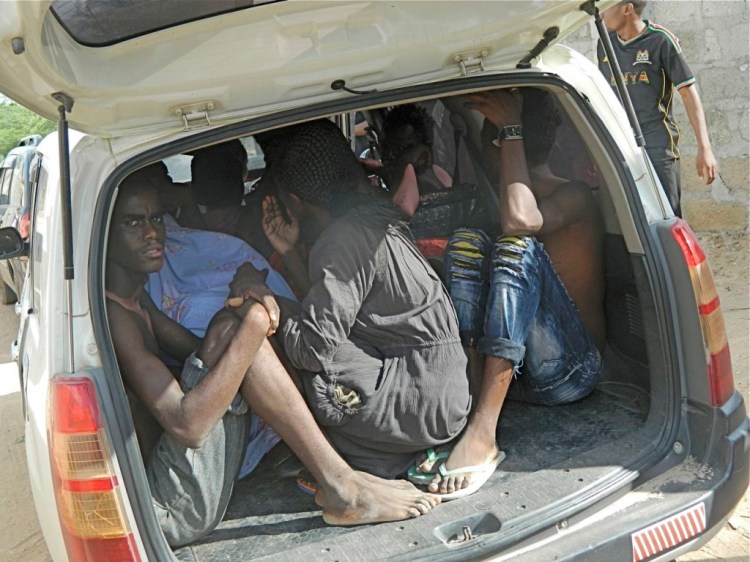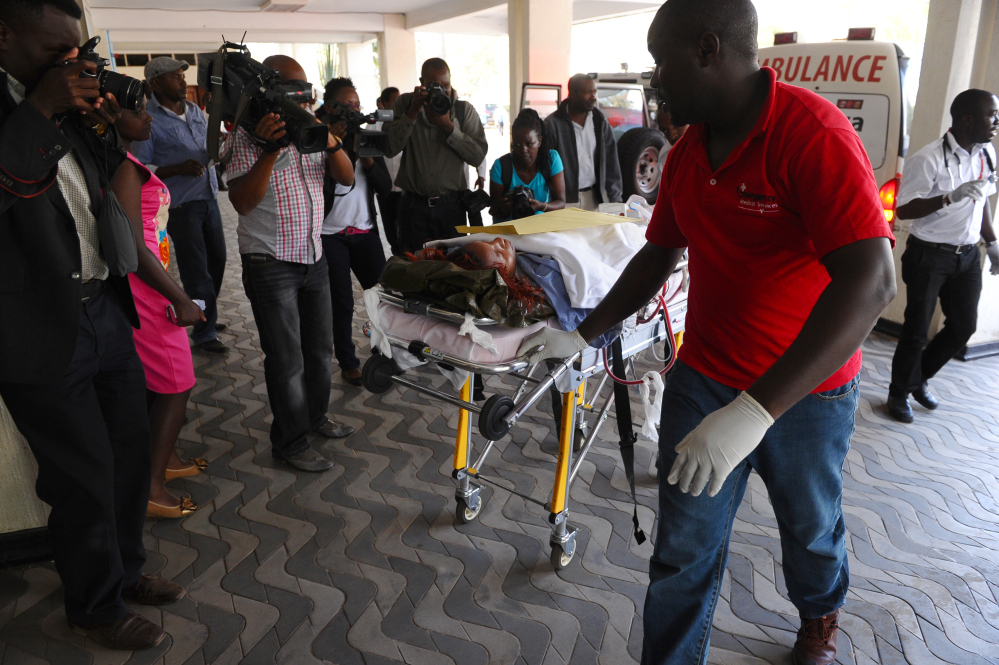NAIROBI — Masked al-Shabab militants stormed dormitories at a university in eastern Kenya early Thursday, killing at least 147 people in the worst terror attack on Kenyan soil in nearly two decades, officials said.
More than 500 students were rescued after the Islamist militants, heavily armed and strapped with explosives, attacked the campus of Garissa University College about 5:30 a.m., shooting some young people and taking others hostage. At least 79 people were injured, according to Kenya’s National Disaster Operation Center.
A government spokesman said the siege ended after 15 hours, with four gunmen from the Somali group having been killed.
“The gunmen are dead. There were four; they are all dead,” said Abdulkadir Sugow, spokesman for the Garissa governor. He could not confirm how they were killed.
“The fire exchange has now stopped,” Sugow said. “The next step is to reconcile and to analyze the way forward.” Security forces had yet to enter the university compound, he continued. “Nothing can be ascertained fully,” he said.
Outside the university in the city of Garissa, about 90 miles from the Somali border, confusion and tension dominated. Scores of students remained unaccounted for; many had jumped through a fence to escape the campus.
The gunmen had been holed up in the compound with an unconfirmed number of hostages. When they were shot by police, they exploded “like bombs,” said Kenya’s Interior Minister Joseph Nkaissery.
Ogutu Vquee, a student at the university, was sleeping in his dormitory when the gunmen arrived. He said there was indiscriminate shooting of both Muslims and non-Muslims, though there were reports that Muslims had been separated from Christians, who were said to be targeted. “When they attacked us, most of us were asleep, so we were woken by the gunshots,” he said. “I am totally in fear and confusion.”
Rosalind Mugambi said she fled her dormitory in a panic, dodging gunfire. Although she had been able to run across the sandy ground into a surrounding field, some of her friends had fallen. “We saw some bloodstains, and they were shot,” she said.
A 19-year-old student from Nairobi, who asked not to be named, said that he had transferred from Garissa University College to Nairobi after threats of an al-Shabab attack circulated in December. “Everybody had to go home because there was a lot of tension,” he said. “Shabab was saying they were going to attack the school in one week’s time, so we went home. It was rumors, but we had to vacate.”
He said the students left in mid-December, missing the end-of-semester exams. “I transferred because of the tension,” he said.
He said he was horrified to learn of the attack Thursday morning: “I was so frightened. People see normality and they think maybe al-Shabab will take two years (to strike). I never ignored the threat.”
The massacre is the worst terrorist attack in Kenya since the bombing of the U.S. Embassy in Nairobi in 1998, which killed 224. An attack on an upscale shopping mall in Nairobi in September 2013 left 67 dead and renewed fears that al-Shabab could wage significant operations from its strongholds in neighboring Somalia.
Since the 2013 attack, the U.S. military has maintained a campaign of targeted drone strikes against the leaders of the al-Qaida-affiliated group. Last month, one such strike killed Adan Garaar, thought to be behind the mall attack and several others in the region.
An al-Shabab spokesman told Agence France-Presse that the gunmen in Thursday’s attack had been holding Christian hostages. “When our men arrived, they released some of the people, the Muslims, and it is they that alerted the government. We are holding the others hostage,” Sheik Ali Mohamud Rage told AFP by telephone.
Al-Shabab considers Kenya an enemy in part because the country sent troops to Somalia in 2011 to fight the group. Kenyan troops remain stationed there as part of an African Union mission.
U.S. drone strikes had recently appeared to be weakening the group, which has also lost territory within Somalia. American troops have been training African Union soldiers to fight al-Shabab terrorists. Western sanctions are also thought to have struck a blow to the group’s finances.
Last year, President Obama pointed to the U.S. strategy in Somalia as an example of a successful counterterrorism campaign. He called it a “strategy of taking out terrorists who threaten us, while supporting partners on the front lines.”
But Thursday’s attack proved that al-Shabab still has the capacity to strike in the region, and with deadly effect.
Kenya’s border with Somalia is vast and largely unguarded. Attacks on many targets, particularly in rural parts of the country, are difficult to prevent. The Garissa campus had little protection, despite recent security alerts at universities across the country.
Kenya is a key U.S. ally in the region, a product of its role in combating terrorism as well as its growing economy and prominence in East African geopolitics.
“The United States stands with the people of Kenya, who will not be intimidated by such cowardly attacks,” White House press secretary Josh Earnest said Thursday.
Last week, al-Shabab militants seized control of a Mogadishu hotel, killing at least 20 people, including Somalia’s ambassador to Switzerland.
Students at Garissa reported seeing notices warning of a possible attack on the campus. “As it was April 1, we just thought that it was fooling,” one student said. Several universities in Kenya reportedly had made students aware of a potential security threat by distributing posters around campuses.
Garissa University College, which opened in 2011, according to its website, is the first and only public university in North Eastern Province.
“This is a moment for everyone throughout the country to be vigilant as we continue to confront and defeat our enemies,” Kenyan President Uhuru Kenyatta said.
Send questions/comments to the editors.




Success. Please wait for the page to reload. If the page does not reload within 5 seconds, please refresh the page.
Enter your email and password to access comments.
Hi, to comment on stories you must . This profile is in addition to your subscription and website login.
Already have a commenting profile? .
Invalid username/password.
Please check your email to confirm and complete your registration.
Only subscribers are eligible to post comments. Please subscribe or login first for digital access. Here’s why.
Use the form below to reset your password. When you've submitted your account email, we will send an email with a reset code.